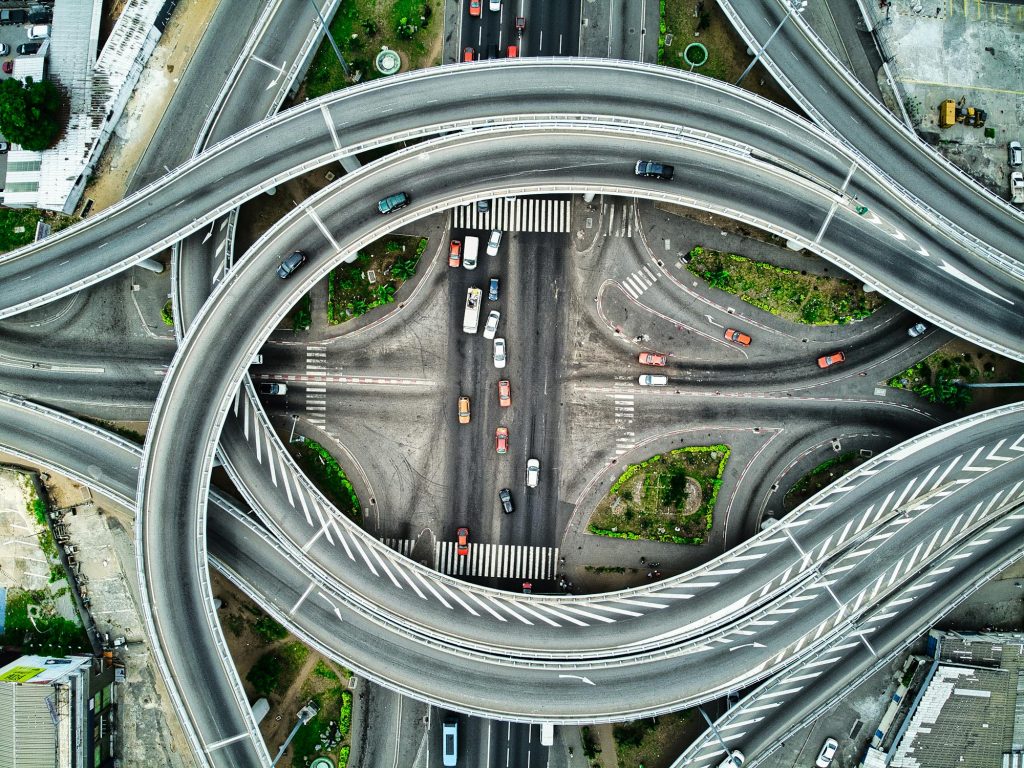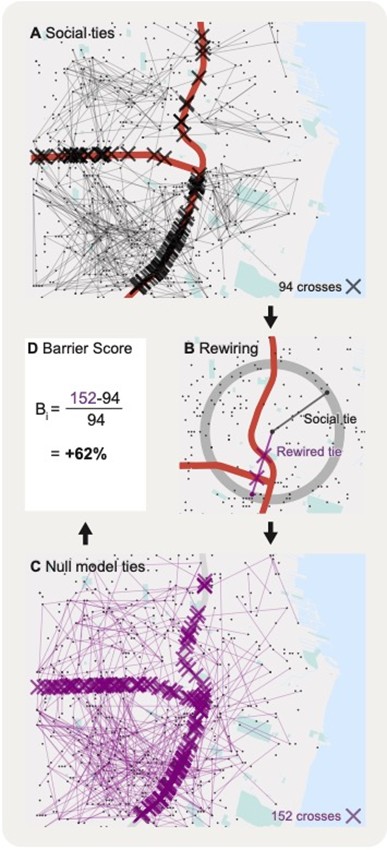
Urban highways are barriers to social ties
by Sándor Juhász
Urban highways are often portrayed as connectors—arteries of modern mobility that bring people and places closer. But from the ground level, they often do the opposite: they divide. Especially in car-centric US cities, highways represent not convenience, but disruption—of neighborhoods, of mobility, and of the social fabric itself.
In our recent study, we revisit a widely acknowledged idea in urban studies: that highways act as barriers to local social interactions. While this notion is well-recognized, there has been surprisingly little quantitative evidence to support it. Using massive, geolocated data from online social networks, we quantify this effect and introduce a novel Barrier Score that captures the extent to which highways inhibit social connectivity across space.

Figure 1. To capture how highways influence social connections, we developed the Highway Barrier Score. (A) Count real social ties that cross the highway. (B) Simulate a random network that ignores highways, reshuffling ties based on distance and population density. (C) Count how many of these random ties cross the highway. (D) Calculate the difference—the higher the score, the stronger the barrier effect of the highway. In our toy example from Detroit, 94 real ties crossed a highway—but 152 would have if the highway weren’t there. That’s a 62% drop, revealing a major barrier to local connection.
From concrete to connectivity
We focus on the 50 largest cities in the United States and examine millions of mutual connections on Twitter. By combining this social network data with detailed maps of urban infrastructure, we are able to measure—at the level of individual ties between places—whether highways are associated with a drop in the likelihood of connection.
Our findings show that across all cities, highways are consistently linked to fewer social ties that cross them, particularly over short distances where we would typically expect high levels of local interaction. In other words, highways aren’t just barriers to walking or biking—they’re barriers to knowing your neighbors.
A legacy of segregation, now measured
The effects we observe are not just incidental—they echo deep historical roots. Our Barrier Score indicates particularly high values for highways that were deliberately constructed to cut through or isolate Black neighborhoods. In these contexts, our findings provide new, quantifiable support for long-standing claims about the social consequences of urban planning decisions.
By bringing together infrastructure data and human networks, our approach opens a new window into spatial inequality. We hope this work can support more informed and reparative urban policy.
Implications for cities
Our findings reinforce the need to view highways not just as transportation infrastructure, but as physical and social boundaries that shape who we meet, befriend, and trust. They suggest that undoing the harm caused by divisive infrastructure requires more than new roads or bike lanes—it requires reweaving the social fabric torn by past planning decisions.
Our work illustrates the social cost of concrete lines on the map. We believe this perspective is crucial for designing cities that are not only more mobile, but also more connected and equitable.
 Aiello, M. A., Vybornova, A., Juhász, S., Szell, M. And Bokányi, E. (2025) Urban highways are barriers to social ties. Proceedings of the National Academy of Sciences 122 (10) e2408937122
Aiello, M. A., Vybornova, A., Juhász, S., Szell, M. And Bokányi, E. (2025) Urban highways are barriers to social ties. Proceedings of the National Academy of Sciences 122 (10) e2408937122


